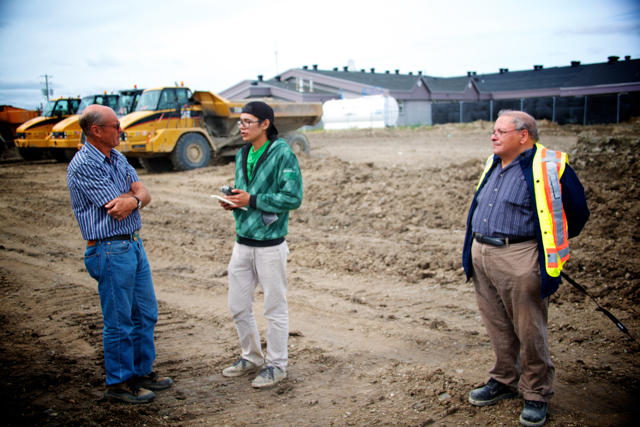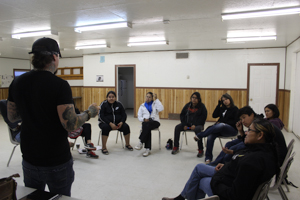NGO launches First Nations journalism project

caption
Richard Spence interviews the head engineer at the diesel leak remediation site in Attawapiskat, Ont.Group sends trainers in to teach photography, reporting
Danny Kresnyak is boxing up antlers and moccasins to send back to his family in Saskatchewan. For three months he has been living in the basement of a Depression-era Roman Catholic church in Attawapiskat, Ont. as a journalism trainer for First Nations people.
Kresnyak is a tattoo shop-owning cowboy boot enthusiast, who left the CBC to become a trainer for Journalists for Human Rights (JHR), a media development NGO based in Toronto. He is in Attawapiskat, the first stop on a tour of northern Ontario, with fellow JHR trainer and journalist Kimberly Stinson.
They are staying on the land of three remote First Nations to teach reporting and photography. Fort Severn, where Stinson was last stationed, is the northernmost community in Ontario, and is only accessible by plane or winter ice roads. Attawapiskat is larger than Fort Severn, with a population of about 3,000, but is isolated on the east bank of Hudson Bay.
By mentoring First Nations people to report on local stories, JHR hopes to increase Ontario media coverage of Aboriginal people.
Training people in Attawapiskat and Fort Severn also allows media organizations, once JHR leaves, to hire a local First Nations person to do local stories, instead of flying journalists in from elsewhere.
Bringing JHR home
This is the first time JHR, which already works with journalists in Africa and the Middle East, has turned its attention to the Canadian North. Project manager Robin Pierro developed the idea in 2011 while working in Ghana. Many people she met abroad were surprised to learn Canada has human rights issues, including limited access to health care and education for Aboriginal people.
Duncan McCue, a professor at the University of British Columbia Graduate School of Journalism, says he advised JHR to make the project specific to First Nations and not to “take the model they use in Africa and plunk it down in First Nations communities.” McCue is also the founder of Reporting in Indigenous Communities, a guide for journalists covering Indigenous news stories.

caption
Trainer Danny Kresnyak leads a workshop in Attawapiskat.When Kresnyak was in Ghana with JHR, he worked in newsrooms and radio stations, mentoring professional journalists. In Attawapiskat, most of the 26 people who came to his workshops on Thursday evenings had other jobs and had never written a news story before. But Kresnyak says he wasn’t starting from scratch. Instead, he helped the people in his class refine their existing photography and storytelling skills.
Sticking to the JHR mandate, Kresnyak worked with students to write stories on human rights issues. Richard Spence, one of these students, explored a remediation site for a diesel leak in Attawapiskat, revealing, among other things, the threats it posed to human health. The leak started 30 years ago from underground pipes, and contaminated the soil under houses, a school and a hospital.
Spence’s piece on the diesel leak was not the first article written on the poor living conditions in Attawapiskat, but one of the first stories written by an insider. “It will be the best story that any media has done on housing in Attawapiskat,” says Kresnyak, “because he’s a person who knows who to talk to, he knows where to go, he knows the sources from the community.”
JHR teamed up with Wawatay News to publish the stories written by the project’s participants. Established in 1974, Wawatay News is the primary First Nations news source in Ontario, with an audience living in an area that spans two-thirds of the province.
Wawatay News editor and publisher Jaime Monastyrski says one of his favourite stories is My life as a trapper in northern Ontario, by Julie Miles of Fort Severn. Miles writes about working trap lines, a skill she learned from her father, and spending three months during the fall in a trapping camp. “Not many women trap in the Northern communities,” says Monastyrski, “and it’s stories like that that you can’t get anywhere else.”
For Monastyrski, the project is bittersweet. “It’s a shame that we have to have Journalists for Human Rights in our communities in 2013.”
Canada’s capacity to listen
According to Statistics Canada population projections, the Aboriginal population is increasing at a higher average annual rate than the non-Aboriginal population. The 2011 report predicts that from 2006 through 2031, the Aboriginal population will increase by up to 2.2 per cent — more than a full per cent higher than the non-Aboriginal population. More people are also identifying as Aboriginal. Still, the amount of media coverage on Aboriginal issues remains low.
In August 2013 JHR released a study on the number of stories on Aboriginal people in Ontario media, and the tone used in these articles. The study surveyed 171 print and online news sources across the province from June 2010 through May 2013. The results showed 0.15 per cent of stories written from June 2010 through May 2011 were about Aboriginal people. In 2013 poor housing in Attawapiskat and Chief Theresa Spence’s hunger strike caused the community to make national news. Combined with the Idle No More movement, the number of stories on Aboriginal people from June 2012 through May 2013 tripled.
Though these events caused coverage to spike, many articles on Attawapiskat alleged that leaders of the First Nation were mismanaging funds, and gave readers one view of Attawapiskat: dilapidated houses. Of the 3,338 stories on Aboriginal people surveyed by JHR between June 2012 and May 2013, 39 per cent were written in a negative tone. The study considered a tone negative when it focused on conflict without mentioning a resolution, and/or portrayed Aboriginal people stereotypically. with references to laziness, addiction and poor education.
Chris Kornacki, field coordinator for JHR, leads a workshop in Thunder Bay as part of the project, to educate local journalists on Aboriginal issues. “What journalists don’t understand is just because a First Nation receives $100 million doesn’t mean they can spend it all on housing,” says Kornacki. “There are just common mistakes in reporting and not telling the whole picture.”
A 2011 Urban Aboriginal Peoples Study, by Toronto-based survey company Environics, found that Aboriginal people in Thunder Bay experience the negative effects of stereotypes daily. The study reported that more than one-third of Aboriginal people surveyed said they have been subject to teasing or insult because of their background.
CBC reporter Jody Porter, currently a Southam Journalism Fellow at the University of Toronto’s Massey College, specializes in Aboriginal issues. She witnessed racism towards Aboriginal people while working in Thunder Bay, and says every Aboriginal high school student she spoke with mentioned having eggs thrown at them or racist remarks shouted from people in passing cars.
Porter sees a link between the media and negative stereotypes of Aboriginal people. For example, “there’s a basic assumption in Canada that all First Nation Chiefs are corrupt.” But she questions whether JHR’s efforts are in the right place. “It’s not about First Nations’ capacity to share their stories – that’s already very well established,” she says. “It’s about Canadians’ capacity to listen, to understand, and to act on those stories.”
Proven commitment
Poor coverage of First Nations issues has created mistrust between First Nations people and the media. In Attiwapskat, says Kresnyak, there is a standing Band Council Resolution which limits media access in the area. “It’s just a bylaw,” he says, “but for an outsider like me, if you hear the (letters) BCR, it means you are getting kicked out.”
JHR trainer Kimberly Stinson says, “there’s no way not to know that you are a white woman. There’s always a level of gaining people’s trust and letting them know that your motives there are to help.” Stinson was told “don’t make promises you can’t keep” early in her placement. She says the first stories her students wrote and Wawatay News picked up proved her commitment to publishing articles about Fort Severn.
Kresnyak says the best thing that happened to him in his first three weeks in Attiwapiskat was not having access to a phone or the Internet. This forced Kresnyak to get into the streets, meet the people of Attawapiskat and explain his efforts. “We can’t just drop into these communities and say, ‘Okay, who wants to learn about journalism’?” says project manager Robin Pierro. Kresnyak immersed himself in local life, visiting traditional sweat lodges and meeting with Chief Spence. He became the Karaoke King of Attawapiskat after a rousing performance of Sweet Caroline at a community fundraiser. He donated his winnings back to the charity, but kept the title.
The project is as informal as it sounds. Mentors’ lessons are based on the interest of the group, and whatever limited resources are available, like cell phones for cameras. “We found very quickly that traditional classroom methods didn’t work,” says Stinson.
Kresnyak learned this on Day One, when he tried to present a Power Point and the projector didn’t work. Thinking on his feet, Kresnyak pulled out three Pez dispensers. After a quick lesson on photographic techniques, groups of students took pictures of the superhero candy dispensers using background elements to convey emotion in the photo. Kresnyak says the photos he got back were “charming.” One woman, in the group assigned to show sadness, spat on the Thor dispenser for effect.
Seeing an interest in photojournalism, Kresnyak launched James Bay Photography, a photo club showcasing pictures taken by people he worked with in Attawapiskat. The Facebook page for the club received more than 1,000 likes in a week, from users all over the world. It even made its way down to Kresnyak’s cowboy boot maker in Las Vegas. The photos of pow-wows, smiling children and natural landscape show a different side of life in Attawapiskat.
Kresnyak plans to continue working with James Bay Photography, but is leaving the management of the page in the hands of local photographer Priscella C. Rose. In every JHR project, trainers try to work themselves out of a job. Kresnyak says it is important for the project to be sustainable, and passing the role of teacher is JHR’s way of making sure training will continue after they leave a community. JHR also launched Dibaajimo, a free online training module for anyone interested in learning about journalism or reporting on First Nations issues.
I would like to see it continue for longer; I don’t think a year is long enough.Jaime Monastyrski, editor of Wawatay News
“I would like to see it continue for longer; I don’t think a year is long enough,” says Wawatay News editor Jaime Monastyrski. Stinson and Kresnyak finish their last placements in July 2014, and a three-year project to follow is already in the works. JHR is trying to connect with First Nations in Manitoba and Saskatchewan, as well as developing courses on First Nations reporting for university journalism programs.
Pierro predicts it will take at least six months for the project to make any measurable change. For now, comments on the James Bay Photography page and stories on Wawatay News show that people are taking notice of the project, and happy to see a different side of First Nations in northern Ontario. “If you look at the comments from people all over Canada,” says Kresnyak, “there’s a sense of pride.”
View JHR Northern Ontario Initiative in a larger map

